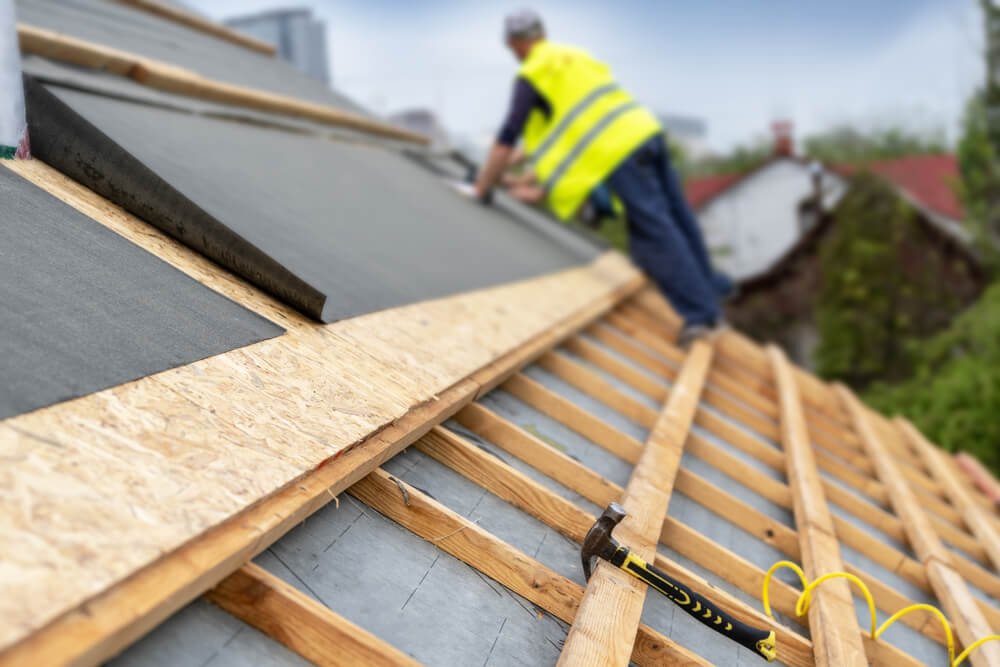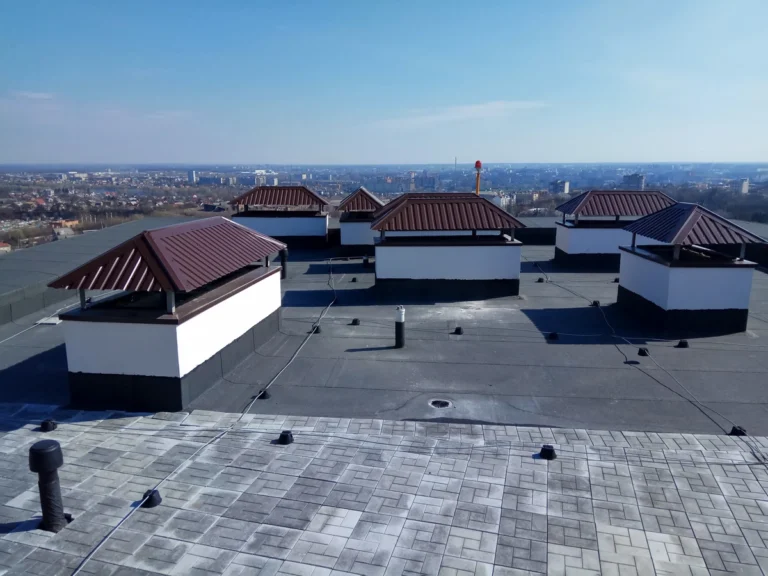Why Calgary Roofs Age Faster — and How to Make Yours Last
Our Roofing Calgary team handles roof installation, repair, and maintenance for residential and commercial properties throughout the city.
Angel’s Roofing has over 25 years of experience with steep-slope and flat roofs, engineered for chinook swings, hail, heavy snow, and UV exposure at altitude.
Crews apply premium shingles, SBS torch-on, and metal systems that adhere to Alberta codes. The job remains clean, secure, and punctual, with transparent estimates and sturdy guarantees.
For more information or a free estimate, please contact our Calgary team today.
Calgary’s Weather Gauntlet
Calgary’s weather gauntlet really puts roofs to the test. It features frigid sub-zero winters, sweltering summers, heavy snowfall, ferocious winds, intense UV radiation, and hail. Rapid shifts from polar freezes to heat establish a bona fide weather gauntlet that challenges materials, seals, and structure all year long.
What Calgary’s Weather Does to Roofs
Freeze-thaw cycles cause expansion and contraction that battle shingles, shakes, membranes and fasteners. This causes cracks, lifted tabs, nail pops and split seams. Heavy UV on Calgary’s dry mountain air heightens asphalt’s granule loss and brittleness by dehydrating asphalt binders.
Hailstorms dent metal, bruise shingles and crack mats, and are often invisible from ground level. Thermal shock from quick temperature swings, from sun to cold front in hours, compromises flashings and sealants. If the slope or drainage is off, heavy rain falls and overwhelms valleys and scuppers.
Over time, these forces reduce roof lifespan and increase the risk of leaks.
Why Durable Materials and Proper Installation Matter
Think Class 4 impact-rated asphalt shingles, SBS-modified shingles, standing seam steel thicker gauges, or premium synthetics that are UV-stabilized. Use ice and water shield in eaves, valleys, and around penetrations, with full eave coverage to 0.6 m past the warm wall.
Proper nailing, sealed flashings, wind-rated ridge caps, and ventilated attic systems are all important. A trusted Calgary roofer, such as Angel’s Roofing, is well-versed in local codes, Chinooks, roof pitch restrictions, and manufacturer specifications to maintain warranty coverage.
How Snow and Swings Stress the Structure
Blowing snow contributes considerable live load, while drifts along hips and behind chimneys cause uneven stress. Rapid warm-ups refreeze at the eaves and gutters, creating ice dams that block meltwater and push it under shingles and underlay.
Water-stained ceilings, wet insulation, and warped decking are next, which can increase repair fees if left unaddressed.
Maintenance That Prevents Bigger Bills
Schedule seasonal roof inspections—post-hail, pre-winter, and post-major melts. Calgary’s weather gauntlet can take a toll on roofs.
Clear gutters and downspouts, check ridge and soffit vents, reseal flashings and replace cracked boots. Install attic insulation and balanced ventilation to reduce ice dams. Tend to small hail, bruised, lifted tabs and loose fasteners early to prevent the need for complete replacement.
The Chinook Effect
Calgary’s chinook winds induce fast changes that can leap from minus 20 degrees to above 0 in a matter of hours. These rapid transitions stress roofs, increase the potential for ice dams, and can spark attic rain from warm, damp air condensing against cold roof decks. The pattern changes every year, so plans have to remain flexible.
How Chinooks Stress Roofing Systems
Chinooks result in rapid construction and contraction of shingles, membranes, flashings and coatings. Nail lines can crack. Rubber and SBS-modified membranes do better but still require tight seams and flexible sealants.
Metal flashing shifts more, so joints, fasteners and transitions at chimneys, skylights and walls require extra flexibility. Uneven warming causes hot and cold spots, which increase energy consumption and may cause edges to curl.
Rapid melts refreeze along eaves and valleys, creating ice dams that drive meltwater under shingles. Attic rain appears when warm air inside encounters the cold roof deck and drips into insulation and ceilings.
Seasonal Roof Inspection Steps
- Late fall: Schedule a comprehensive roof and attic inspection before the freeze.
- After the first deep cold, review flashings, ridge caps, and sealants.
- After the first major Chinook, inspect eaves, valleys, and gutters for ice damage.
- Mid-winter: quick attic scan for frost, wet insulation, and stains.
- Early spring: full inspection for lifted shingles, split seals, ponding, and soffit stains.
- After a hail or wind event, conduct a targeted spot check of impact and uplift points.
- Record every visit with photographs and moisture readings for trend analysis.
- Schedule minor fixes within two weeks to prevent spread.
Materials That Handle Thermal Cycling
Top-of-the-line asphalt shingles with SBS-modified mats, rubber (EPDM) systems, and flexible underlayments at eaves and valleys. Combine with self-adhered ice-and-water shield, high-elongation sealants, and vented ridge systems.
Insulate and ventilate to keep attic rain and ice dams at bay. In Calgary, nimble choices manage the most brilliant wobbles in Canada more effectively than inflexible ones.
Timely Repairs and Routine Care
Seal small splits early, reset loose flashings and clear gutters before warm spells. Address attic moisture by air sealing, installing supplementary insulation, and ensuring balanced intake and exhaust ventilation.
Speed is the essence when Chinooks reiterate.
Choosing Your Armour
Make roof decisions in Calgary that can take a lickin’ — hail, intense UV at altitude and freeze-thaw swings. Select material based on roof pitch, snow load and budget. Then complement it with appropriate underlayment and vents to create a tight, long-lived system.
Roofing Materials and Benefits
- Asphalt shingles (laminated) have strong hail ratings, good UV hold, are cost-effective, and come in a wide colour range.
- Asphalt shingles (tab) have a lower cost, lighter weight, shorter life, and basic curb appeal.
- Steel standing seam sheds snow quickly, offers high wind resistance, provides good hail resistance, and has a long lifespan.
- Stone-coated steel offers a textured appearance, enhanced dent masking, and superior freeze-thaw performance.
- Metal panels (galvanized/galvalume) are durable finish options that provide good UV and ice resistance.
- Concrete tiles have a long service life and strong hail tolerance. Verify the structure first if it is heavy.
- SBS-modified asphalt shingles are flexible in cold weather, have better crack resistance, and provide improved seal.
- Flat roofing (SBS torch-on) is strong in freeze-thaw, has resilient seams, and is good for low-slope.
- Flat roofing (TPO/PVC) offers reflective properties, heat-welded seams, and good UV defence on commercial roofs.
Climate Fit: Hail, UV, Freeze‑Thaw
Speaking of ‘choosing your armour,’ Asphalt laminated or SBS-modified shingles resist hail and cold snaps better than tab shingles. Steel and stone-coated steel withstand impact and shed ice.
Avoid softer metals like aluminum, which can weaken at seams due to wind and winter contraction. Concrete tile is effective in Calgary when properly cared for and when the framing can support the additional weight.
For low-slope areas, choose SBS, TPO, or PVC. Most pitched products require slopes above 4:12 to shed water effectively. Pitch is the feet of rise in a 12-foot run; check before you spec.
System Upgrades That Pay Off
Go for Class 3 to 4 impact-rated shingles or steel, high-end UV-stable coatings, and complete ice and water shield at eaves and valleys. Underlayment brings it to life by keeping out the water, reducing heat and noise, and dampening temperature fluctuations.
Asphalt felt is available in 15 to 30 lb, with 30 lb being more water resistant. Measure materials in ‘squares’ where 1 square equals 100 square feet and add roughly 10 percent for waste.
Lifespan and Performance in Calgary
| Roof Type | Lifespan (years) | How it performs with Calgary weather |
| Asphalt—tab | 12–18 | Fair, less hail resistance |
| Asphalt—laminated/SBS | 20–30+ | Good, better hail/UV |
| Steel standing seam | 40–60 | Excellent, snow/ice shedding |
| Stone‑coated steel | 35–50 | Outstanding, hides dents |
| Concrete tile | 40–60+ | Good, check structure |
| SBS torch‑on (low‑slope) | 20–30 | Good, freeze‑thaw tolerant |
| TPO/PVC (low‑slope) | 20–30 | Good, strong UV seams |
Proactive Roof Maintenance
Calgary’s freeze-thaw cycles, chinook winds, hail, and UV exposure all take a toll on roofs. A scheduled, proactive program preserves structure, reduces lifetime cost, and maintains warranties.
What Proactive Maintenance Includes and Why It Matters
A sturdy plan includes biannual inspections (in spring and fall), gutter maintenance, and debris clearing following storms. Keep eavestroughs and downspouts clear of debris to maintain drainage, prevent ice dams, and stop fascia rot.
Clearing debris captures moisture traps and shingle wear. Routine maintenance adds years, prevents shock, and supports the frame. A stitch in time, roof repair and maintenance adds years and reduces the cost of big repair bills.
Annual Service With a Local Calgary Roofing Company
Schedule an annual service visit with a trusted Calgary contractor, such as Angel’s Roofing, to maintain all parts in prime condition. A local crew understands hail, wind, and snow loads from Tuscany to Mahogany.
Lab-tested reporting, photos, and minor on-the-spot repairs reduce risk and cost. Pair this with a five-year roof tune-up or sooner, after strong winds or hail, to re-secure fasteners, reseal flashings, and prevent small leaks from developing.
Detailed Checklist: What We Inspect and Address
- Roof penetrations: Check vents, chimneys, and skylights for proper sealing. Reseal perimeters. Replace cracked gaskets. Confirm storm collars are tight.
- Flashings: Inspect step, wall, and valley flashings. Re-seat with proper fasteners. Add compatible sealant. Replace corroded pieces to prevent capillary leaks.
- Attic insulation and ventilation: Verify even insulation depth, clear soffits, and correct vent balance to curb ice dams and moisture. Watch for frost on sheathing during cold snaps.
- Drainage systems: Clean eavestroughs, confirm that downspouts discharge away from foundations, secure hangers, and correct improper slopes to ensure steady meltwater flow.
- Field shingles: Re-fastening or replacing loose or missing shingles, sealing loose tabs, repairing punctures, and countersinking ridge and hip caps.
Shingle Rejuvenation and Protective Coatings
If you have an aging asphalt roof, shingle rejuvenation oils return binder flexibility, reduce granular loss and enhance UV resistance.
Elastomeric or acrylic coatings on the low-slope sections provide a water-shedding layer, reduce thermal stress, and extend the replacement interval. A proactive program that includes evaluation, resealing, re-fastening and leak repair extends the roof life cycle and lowers long-term costs.
Spotting Trouble Early
Early inspections help Calgary homes and buildings prepare for hail, chinooks, deep cold, and high winds. Prompt attention reduces potential issues, lowers expenses, and extends the lifespan of your roof for residential and commercial locations throughout the city.
Common Signs of Roof Damage in Calgary
- Missing, broken, or curled shingles, in particular on the west and south slopes.
- Granules piling in gutters/downspouts; bare shingle spots on slopes.
- Metal flashing, vents, gutters, or chimney caps that have dents or dings.
- Soft spots on the sheathing with a spongy sensation when perched under eaves.
- Water stains on ceilings or top-floor walls, musty attic stench.
- Peeling paint or wallpaper from dampness. Swollen trim bythe ceilings.
- Rusted or loose fasteners on metal roofs. Lifted panels at the seams.
- Loose ridge caps; split rubber boots at vent stacks.
- Ice dams at eaves, long icicles, and tamped snow above frigid eaves.
- Sagging gutters and downspouts are plugged with shingle grit or hail debris.
Inspect After Weather Swings
Visual scans after hail, wind gusts, heavy snow or rapid freeze-thaw are essential. Catch trouble early. From the sidewalk or a sturdy ladder, keep an eye out for raised shingles, missing tabs, bent flashing and ridge cap openings.
For winter, be on the lookout for ice dams and heavy drift lines. In spring, watch for staining after the melt. Seasonal inspections, conducted at least once a year, can spot small leaks and nail pops in time before they leak through the underlayment and sheathing.
Bring in a Pro for Deep Checks
Hire trained Calgary roofers for thorough inspections, leak detection, and moisture testing. Pros check membrane seams, flashing steps, skylight curbs, and attic ventilation to help prevent moisture accumulation and minimize the threat of ice damming.
Hail problems can lurk. A trained eye detects micro bruise crops, smashed mats, and dings on alloys. This translates into detailed reports that not only guide repair scope but also come in handy with insurance after storms.
Fix Small Issues Fast
Get ahead of trouble by repairing flashing and a few shingles, resetting loose fasteners, removing ice dams safely, and improving attic airflow. Early detection and repair can save serious time and money.
These timely fixes can stave off major water damage or replacement and preserve warranties.
Calgary’s Building Codes
Calgary roofing must comply with the Alberta Building Code (ABC), which modifies the National Building Code of Canada to account for local loads, weather, and materials, as well as City of Calgary bylaws. This applies to every work, even when no permit is required.
Key Calgary Roofing Codes and Regulations
| Requirement | What it covers | Calgary/ABC specifics | Why it matters |
| Structural loads | Snow, live, dead loads | Roofs designed for significant snow based on local data | Prevents sag, collapse, and service shutdowns |
| Wind resistance | Shingle fastening and rating | Asphalt shingles are typically rated 110–130 km/h | Reduces blow‑offs in Chinook wind events |
| Hail/impact rating | Material durability | Class 3 or 4 impact‑rated shingles are recommended | Lowers hail damage risk, may aid insurance |
| Drainage | Eavestroughs, scuppers, slope | Code‑compliant roof slope and drainage paths | Limits ponding, leaks, and ice buildup |
| Ventilation | Intake/exhaust, airflow | Balanced ventilation to stop condensation and ice dams | Extends shingle life, protects sheathing |
| Underlayment/ice barrier | Secondary water protection | Ice‑dam membrane along eaves and valleys | Controls meltwater intrusion |
| Flashing | Walls, chimneys, penetrations | Metal flashing sized and lapped to code | Seals common leak points |
| Materials bylaw | Approved products | Local bylaws set roofing material standards | Ensures fit for Calgary climate |
Why Certified Contractors Matter
Accredited roofers working in Calgary understand ABC clauses, local bylaws, and inspection procedures. They select rated shingles, install the proper ice and water membrane, size vents, and fasten them according to wind specifications. That keeps red tags, rework, schedule slips and excess costs at bay.
It complies with manufacturer installation regulations, preserving product warranties.
Safety, Structure, and Insurance
Calgary’s Building Codes ensure that code-built roofs hold design snow loads, shed water and vent moisture. This translates to fewer leaks, less deck rot, and better fire and wind performance.
Insurers frequently require impact-rated shingles and evidence of code compliance, so upgrades such as Class 4 shingles and strengthened nailing can increase eligibility and claims success.
Documentation and Warranties You Should Expect
Request permit status, compliance letters, spec sheets with wind and impact ratings, ventilation calculations, and photos of ice‑barrier zones. Ask for a workmanship warranty in writing from the contractor and a manufacturer’s warranty with system registration.
We provide close‑out packages with code references, installed product lists and warranty certificates for every Calgary project at Angel’s Roofing.
Conclusion
Roofs in Calgary take a hit. Chinooks, deep freeze, hail, intense UV. Good prep delivers! Solid construction, intelligent maintenance, and obvious code inspections. That holds heat in, leaks out, and bills down.
Angel’s Roofing delivers 25 years of experience on Calgary roofs. Crews are neat and safe. We incorporate top shingles, underlay, and ice shield that takes care of freeze and thaw. We monitor code changes. We back it up with transparent quotes and actual completion dates. No estimation.
Need a new roof in Varsity? Looking for hail repair in Mahogany? Flat roof in the Beltline! We do homes and shops.
For no-nonsense advice and a fair price, contact Angel’s Roofing. Give Angel’s Roofing a call, get a free estimate, or schedule a site visit today.
Keep an eye for more latest news & updates on knowledgearrow!




